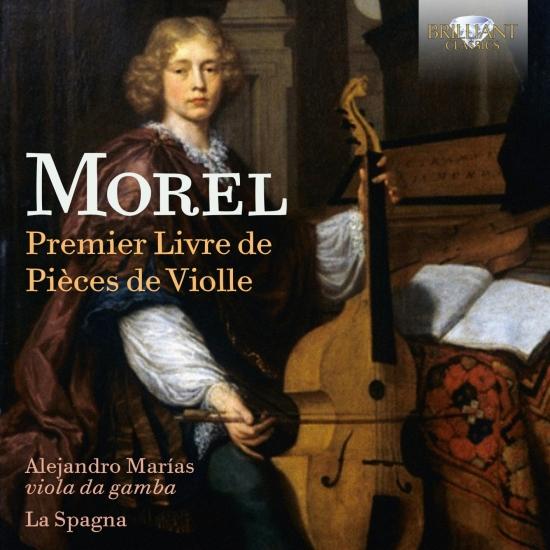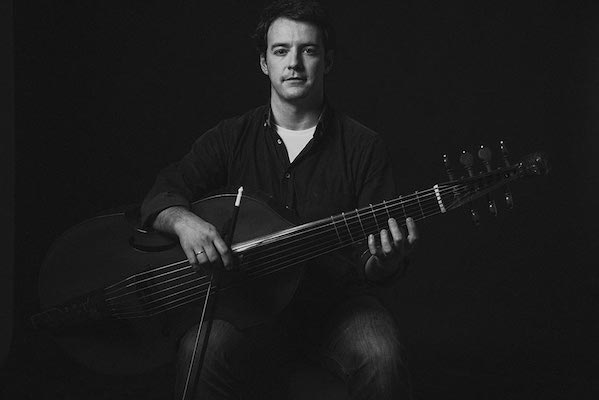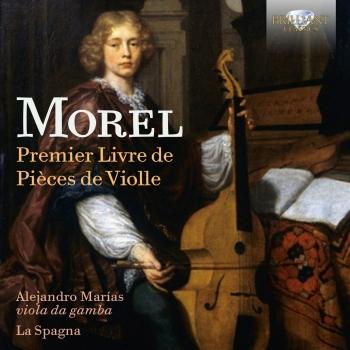
Morel: Premier Livre de Pièces de Violle La Spagna & Alejandro Marías
Album Info
Album Veröffentlichung:
2019
HRA-Veröffentlichung:
29.03.2019
Label: Brilliant Classics
Genre: Classical
Subgenre: Chamber Music
Interpret: La Spagna & Alejandro Marías
Komponist: Jacques Morel (1700-1747)
Das Album enthält Albumcover Booklet (PDF)
- Jacques Morel (1690 - 1740): Suite No. 1 in A Minor:
- 1Suite No. 1 in A Minor: I. Prélude. Lentement - Vîte03:47
- 2Suite No. 1 in A Minor: II. Allemande02:00
- 3Suite No. 1 in A Minor: III. Courante01:55
- 4Suite No. 1 in A Minor: IV. Sarabande l'agréable03:32
- 5Suite No. 1 in A Minor: V. Gigue01:11
- 6Suite No. 1 in A Minor: VI. La bretonne. Gratieusement03:26
- 7Suite No. 1 in A Minor: VII. Menuets I & II02:05
- Suite No. 2 in D Minor:
- 8Suite No. 2 in D Minor: I. Prélude02:04
- 9Suite No. 2 in D Minor: II. Allemande la jolie02:00
- 10Suite No. 2 in D Minor: III. Courante la dacier01:29
- 11Suite No. 2 in D Minor: IV. Sarabande03:04
- 12Suite No. 2 in D Minor: V. Gigue l'inconstante01:14
- 13Suite No. 2 in D Minor: VI. Le follet02:16
- 14Suite No. 2 in D Minor: VII. La fanchonette00:52
- Suite No. 3 in D Major:
- 15Suite No. 3 in D Major: I. Prélude02:29
- 16Suite No. 3 in D Major: II. Boutade de Sainct Germain00:58
- 17Suite No. 3 in D Major: III. Allemande la brillante & Double02:55
- 18Suite No. 3 in D Major: IV. Courante01:26
- 19Suite No. 3 in D Major: V. Sarabande l'Aurore02:06
- 20Suite No. 3 in D Major: VI. Gigue à l'anglaise01:28
- 21Suite No. 3 in D Major: VII. Gavotte01:04
- 22Suite No. 3 in D Major: VIII. Fugue. Gayment03:02
- 23Suite No. 3 in D Major: Échos de fontainebleau02:01
- Suite No. 4 in G Major:
- 24Suite No. 4 in G Major: I. Prélude. Lentement02:01
- 25Suite No. 4 in G Major: II. Fantaisie. Gayement00:58
- 26Suite No. 4 in G Major: III. Allemande01:29
- 27Suite No. 4 in G Major: IV. Courante01:37
- 28Suite No. 4 in G Major: V. Sarabande02:20
- 29Suite No. 4 in G Major: VI. Gigue à l'italienne01:20
- 30Suite No. 4 in G Major: VII. Rondeau dauphin04:18
- 31Suite No. 4 in G Major: VIII. Menuet00:38
- 32Suite No. 4 in G Major: IX. La guerandoise & Double01:15
- Chaconne en trio in G Major:
- 33Chaconne en trio in G Major07:06
Info zu Morel: Premier Livre de Pièces de Violle
French Baroque chamber music by a much-admired contemporary of Marin Marais.
In a personal introduction to his own authoritative booklet essay, the Spanish violist Alejandro Marías relates how he acquired the rare facsimile of an even rarer manuscript, and came to realise that its contents had never seen the light of day in the modern era, let alone received attention on record. Thus he presents here the First Book of pieces – a second does not survive – by Jacques Morel.
The volume itself was published in 1709, two years before Marin Marais’s Third Book of pieces. Morel’s date of birth is now obscured by time, but we know that he was this book. And indeed Morel makes no a pupil of Marais, to whom he dedicated attempt to disguise the debt he felt to his master within his music.
The book contains four Suites for viola da gamba and continuo – in A minor, D minor, D major and G major, respectively – and a Chaconne en trio for a traverso flute, viol and basso continuo. This gentle and courtly six-minute Chaconne is the only piece of Morel’s that is regularly performed, but the four Suites are full of delightful discoveries. The second of them begins with a Prelude of bold and grave gestures which introduce a colourful suite of character pieces: the Allemande la Jolie (‘The pretty one’), the Courante la Dacier, a gentle, dream-like Sarabande and the Gigue l’Inconstante (‘The faithless one’). To end, there is an enjoyable rondeau, Le Folet (‘The imp’), and La Fanchonnette, reminiscent of a gavotte in feel and structure.
The other three suites are no less picturesque, and they are brought to life once more on this album by an early-music group founded in 2009 and named after a popular Renaissance dance. La Spagna has been awarded Spain’s GEMA prize for best young Early Music group.
Very little is known of the life of Jacques Morel (fl. 1700-1747) except that he was a pupil of the great composer Marin Marais, to whom he dedicated his “premiere livre de pieces de violle”.
The book that contains the pieces of this disc was printed for the first time in 1709, two years before Marin Marais published his Troisième Livre de Pièces de Viole. Morel's music is, of course, very much influenced by that of his teacher, and the author not only does not hide this heritage but he boasts about it.
However, Morel is a later generation and knows how to introduce certain very important innovations in writing for viola da gamba. From the instrumental point of view, Morel's music is closely linked to the French tradition, but you can see an evolution in his fingerings.
Spanish Viola da Gamba player Alejandro Marías studied with Jordi Savall, Anner Bylsma, Christophe Coin and Jaap ter Linden. He is artistic director of the ensemble La Spagna, with whom he discovers and performs hidden treasures of the Baroque.
The excellent liner notes in the booklet are written by the artist.
Alejandro Marías, viola da gamba
La Spagna
 Alejandro Marías
Alejandro Marías
was born in Madrid in 1984, and graduated in cello and viola da gamba from Madrid’s Real Conservatorio Superior de Música, having begun his studies with Enrique Correa and Maria de Macedo. He moved to France to specialise in Classical and Romantic historical performance practice, before gaining a place at Geneva’s Haute École de Musique, where he completed master’s degrees in both Baroque cello performance and viola da gamba performance, under the guidance of Bruno Cocset and Guido Balestracci respectively. He has also taken classes with such eminent cellists as Christophe Coin, Anner Bylsma and Jaap Ter Linden and gambists Wieland Kuijken, Jordi Savall and Hille Perl.
Alejandro Marías teaches viola da gamba at Seville’s Conservatorio Superior de Música, as well as being artistic director of La Spagna and a member of the Cuarteto Francisco de Goya, and performing with groups such as Zarabanda and Forma Antiqva. He has appeared with different chamber ensembles in around twenty countries. As a soloist he regularly gives concerts and recitals and has made a number of recordings. He has been particularly highly praised for his performances of the viola da gamba solos in the Bach Passions.
He has worked with such leading conductors as Philippe Herreweghe, Marc Minkowski, Ton Koopman, Bruno Weil, Sigiswald Kuijken, Hervé Niquet, Lucy van Dael, Paul Agnew, Enrico Onofri and David Stern, and has made recordings for Warner, Winter & Winter and Columna Música, as well as for various radio and TV stations in Europe, America and North Africa. In 2017 he recorded his first album as soloist and conductor, A Tribute to Telemann, which includes three works for viola da gamba and orchestra, and has received worldwide critical acclaim.
La Spagna ensemble
was founded by Alejandro Marías in 2009, taking its name from the so called popular melody, played all around Europe from the 15th to the 17th centuries.
Depending on each repertoire, which generally involves renaissance, baroque and early classical styles, La Spagna may have a different assemblage, from small chamber music group to opera and orchestral productions with invited conductors.
La Spagna plays with original instruments or adapted copies to each period and style, and is focused on a historical informed practice. This doesn’t have an archaeological objective, but purely artistic: the closer we are to the composers, the more intense we’ll be able to get across their emotions.
La Spagna players are young professionals educated in the most prestigious conservatoires of Europe (Paris, Geneva, Den Haag, Basel, Amsterdam, Vienna…), and they are often collaborators amongst some of the most important orchestras, conductors and soloists of early music international scene, such as Philippe Herreweghe, Marc Minkowski, Ton Koopman, Bruno Weil, Sigiswald Kuijken, Hervé Niquet, Lucy van Dael, Paul Agnew, Enrico Onofri, Hiro Kurosaki or David Stern. They are the image of a new generation of players engaged not only to give an impeccable performance, but also to respect the historical and sociological perspective of each repertoire.











